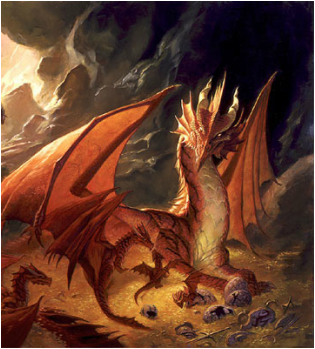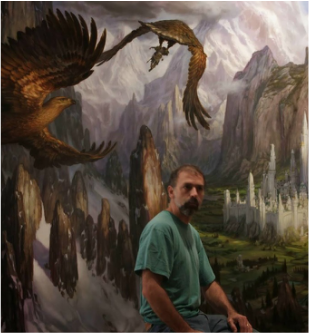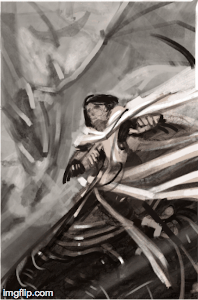This last weekend I ventured south to Portland in order to showcase at my very first convention.
For the month beforehand, off and on while finishing up some recent commissions, I prepared for the event with all the vigor of a hungry dwarf at happy hour. For the sake of transparency, I wanted to go over both the tedium and joys that went along with the process, then break down some of the things I learned at the show. It's been three days since I broke down my booth and while there's still so much information to digest I'll try to be as informative as possible.
PREP
The first thing to do was reserve the space. I opted for a corner booth in artist alley, as opposed to a single table, right off the bat as it was just a small extra cost for this show. With that in mind and the dimensions of the table in-hand I set about putting everything together.I have the amazing opportunity of being an assistant to Todd Lockwood and despite the knowledge I receive on a daily basis working in the print shop I'm also granted use of his printers at cost. This great because I didn't have to order out my prints at a higher cost and could make changes to what I was bringing on a dime if need be. I knew I wanted to bring 8x10" prints, as I've seen others do, but what other sizes? Stepping into the local frame shop, I took note one day of the most cost-effective, durable, and elegant frames to make up my mind. After getting those sizes figured out and budgeted in, I went with printing a run of 12x16 and 16x20 prints.
Now, from looking over other people's setups, I knew basically what I wanted from my tables. I came up with having larger frames on the side facing more toward the main stage. These would be my "head-turners." The other table, facing toward the other artist's booths would have my 8x10's propped up on a wall I built from hollow cloth office-crates. I'd seen Pete Mohrbacher use a method similar to this at GenCon and wanted to give it a try. After getting all of my prints bagged, some framed, and some backed, I did a test setup in the studio.
 |
| testing |
For those of you interested in my materials:
- My 8x10s were printed Epsom pro quality photo paper, backed with chip board from Uline, and bagged with sealable envelope bags from Clearbags. I printed titles on matte board and then cut them individually, taping them to the back of my prints. (I'll want to find longer paper next time, or maybe not. I liked the small labels I was left with as they take up less space and are less susceptible to damage)
- My other sizes were printed out to size on an Epsom 7890 and bagged using a roll of plastic and bag cutter. I printed using roll paper, but may switch over to sheet paper to keep the size accurate.
- Some displays were backed with foam core I had to cut to size and then mount using shrink-wrap. This is something that is expensive if you don't have it in-house. Next time I may even go with display envelopes or pre-sized bags just to try.
I did also purchase a banner for the convention. It didn't cost much and turned out to be a much higher quality than I initially expected. You can see it in the photos and buy your own from Printrunner. I'm happy to point business their way.
PACKING
Packing for conventions, from what I know and have learned helping Todd, is one of the most important parts of attending. Thankfully, I was driving as opposed to flying so the only limit to what I brought is what I could carry on my back. I say that because I didn't want to deal with the hassle of driving up and parking to load my things onto the show floor when I could simply catch an Uber and walk right in.
I packed my largest (18x24") suitcase with tablecloth (wrinkle proof fabric. if anyone knows the technical name can you let me know?), 8x10's, smaller frames, money box, notebook, tape, and gold sharpies (my new best friend).
For my larger prints, I built a carrier out of foam core, compressed them, and cut a handle (I say that I did it, but most of this one was an experienced Lockwood's idea). The only problem was the larger frame. It wouldn't sit int he suitcase and I didn't want to leave it behind. Using the corners that came with it, and some angled packing tape, I secured it to the outside of my homemade carrier.
So, when I walked into the convention I'd have a suitcase in one hand, my flat carrier in the other, and my banner case over one shoulder. It was simple, light, and easy.
A note: if I had shipped all this or took it with me on a plane, I'd have easily spent over $100. Not to mention my small bag of clothes.
THE SHOW
When I'd hit the ground in Portland I checked into my place and went straight to the convention. To my surprise after setting up- I realized that the exhibitors were meant to be there that very night from 5-10pm. Whoops! I'd expected the show to start the next day. At this point I was running on 3 hours of sleep (watch those nerves) and not too much food. I took a stroll downtown and had a bite to eat, took a pre-game nap at my place, and headed back in to start the show.
As the time neared for the doors to open I found myself all the more nervous. It's that anxious kind of excitement that comes with every great endeavor, a mix of impending doom or failure and the exhilaration of conquest and action. I've never been to war, and I'm not a warrior, but I might have felt just a small taste of what standing on the front lines is like. You've prepped for this moment for years. With every brush stroke and anatomy lesson you've dreamt of one day being able to show your work like all your heroes before you. I can tell you that I see the real pros with all the more awe now that I know how easy it's not.
The doors opened and the sounds of marching feet echoed toward me. Meandering and foreign-sounding throngs of voices moved closer. It was my luck to be on the other end of the hall than the entrance, so I was greeted with a trickle that announced the coming flood. It didn't make it easier. An hour went by with few visitors and lots of those head-turns. A few hours later at the end of the night I'd made a few sales and a few friends. It was a great small-batch to start things off with for a newcomer. I went back to my room to sleep.
Saturday greeted me with the idea that I'd now have to stand behind my booth for 12 hours. 10am-10pm. I mean stand- I've heard so many times that you shouldn't sit down, and I wasn't planning on it. I'm not sure I would have, anyway. I couldn't imagine talking to someone about art sitting down!
I had a large breakfast, knowing I wouldn't be having any lunch or dinner for a while, and headed in. In comparison, Saturday was a tsunami to the waves of Friday night. People were everywhere and I made even more friends and even more sales. What took me aback the most is the idea that someone who's never met me wanted something that I'd made. I can feel myself welling up at the thought that this thing I've worked for years on made a connection with someone enough for them to spend their hard-earned money on. I came away with a few more sales and a lot more friends.
At the end of the show, I wandered over to see how Allen Panakal had done that day. Allen is a fine artist and if you don't know his work I'm not sure what you're still doing here. After talking shop for a while, Allen pointed me the direction of doing away with my 8x10's. The idea behind it is that it kills profits- people will always buy them over a higher priced piece. I took the night to think about it.
See, I do care about profit when I've spent money to be at a show, but I came as a friend and a fan first. I wanted to get out there and really see what it was like, connect with people I couldn't otherwise. What really won the idea over for me was the art as a piece of work more than an item. I want people who buy something from me, direct from the artist, to feel like they've carried away a real piece of my work. An 8x10 vs a 12x16 print makes a huge difference to that end. I also want to do my paintings justice and very few of them were painted at an 8x10 size.
 |
| Sunday Best |
That said, Sunday I took down the 8x10's. This ended in disaster for about 2 hours. I hadn't brought a way to display my larger work outside of their free-flowing bags. No one could even see my work outside of the frames because it was out flat on the table. I ended up having to put the 8x10 prints back up, while leaving the 12x16's out on the table surface. This worked surprisingly well, as people could be brought in by the standing displays and then get a closer look with the larger prints. It also better let them know by seeing that the larger sizes were available, ending in more people buying them.
I came away Sunday with a lot to process, went out to dinner with some new found friends, had a very very long sleep with some very exhausted feet, and drove back the next day.
My first convention ended well. From a monetary standpoint I made just under my cost. From an experience standpoint I could never have learned anything without diving in. I can now tell you what my most desirable works are. I can tell you what people relate to most in my work. I can better prepare for next time. I have a new found inspiration to move forward, and a new love for crowded places full of fanciful costumes.
 |
| Jyn- professional cosplayer |
FINAL THOUGHTS
So, what's going to happen next time? What did I learn?
- For one thing, I'm doing away with the 8x10's, and lowering the costs I had set for the larger sizes. It's very important to me that people can afford the prints I want to provide while also making it possible for me to attend the conventions and make back costs.
- I don't want to be behind a table anymore. One thing I disliked was that when I was talking there was a physical barrier between artist and buyer and I can't resolve that to my satisfaction. I'm not sure what the next setup will be or how much it will cost me, but I want people to be able to walk up to my paintings and into my space like a gallery, and stand toe-to-toe if they want to talk to me.
- "Your art is unlike anything else." I heard this over and over again, and it's true. I learned to paint in oils and my first loves were the classics. I'm a huge fan of history and storytelling and I strive for my art to invoke those classical aspects of fine art. I don't think that I'm better than anyone else. Actually, I have a great respect for modern art and design qualities from my education, but what I'm striving for inspires a more fine art salon style of presentation. I'll make moves to retain that feeling in future setups.
- For anyone who's thinking of exhibiting here's some things to consider: bring breath mints, bring hand sanitizer, bring comfortable shoes or insoles, consider your art style and build your booth around it, spend the money to mount your work or make it presentable, folders are nice and easy to flip through- as our boxes of prints- but have that head-turner, tell people that you're the artist- you'd be surprised how many times I was asked, have something prepared to say about each piece, bring some form of originals even if it's special editions of a digital print, take care of your customers and make friends with them- learn from them- I had my best moments laughing and conversing about my favorite things with other like minded people, keep track of things as they happen in a book- you won't remember, learn to recognize other artists (they stare the longest, usually) and talk to them- offer advice and help to students.
Lastly,
THANK YOU to everyone who came out to see me, everyone that walked by for a chat, or bought a piece of my art. I hope you'll keep in touch and we can talk more!
Thank you to Allen Panakal for the advice, to Sam and Pete from One Fantastic Week for their weekly wisdom, to Todd Lockwood for the help and use of his store, to Chance for coming to visit and drudging through the exhaustion so I wouldn't have to be alone, to Steve Oaks for coming to chat during the slow times, and to everyone else who made me feel at home. What a wonderful experience.
If I think of anything else, I'll add it. If you know something I don't or have thoughts, please let me know.

















































